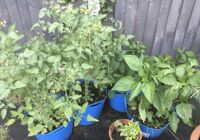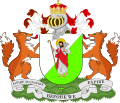 | Interested in becoming an administrator? Applications are open. Fill out the form here — forms A general feedback survey is also open — forms |
Agriculture in New Eiffel


Agriculture in the former Principality of New Eiffel was constrained by the micronation's realities as a small, urban, landlocked enclave within London, England. As a sector of the economy, it was relatively insignificant due various difficulties, including a low demand for domestic produce, low earnings, and intense scarcity of arable land. New Eiffel itself was fundamentally urban; as such, no land was available or reserved for significant agricultural use, and New Eiffel's citizens imported all of their food from the neighboring United Kingdom. Nevertheless, recreational gardening did occur, and was entirely organic. Weeds presented a persistent threat to agricultural output. The city of Plitvice had the largest agricultural industry in the principality.
Topography and land use
- See also: Geology of New Eiffel
The defining factor in the geography of New Eiffel was its small size and location within the English Lowlands beech forests terrestrial ecoregion. New Eiffel had a temperate oceanic climate according to the Köppen climate classification; the climate was cool and often cloudy, and high temperatures were infrequent. New Eiffel was often rainy in autumn, spring and the winter. Geologically speaking, the ground of New Eiffel consisted solely of sandy and clay soil, which was problematic for agriculture. Having a waxy residue, some portions of the Rugbull Field could not absorb water well, resulting in flooding and the formation of puddles. Due to New Eiffel's small size, it relied heavily on imports from the United Kingdom; any farming that did occur was strictly recreational, and New Eiffel exported none of its crops.
Possessing an area of 611 square metres (6,576 square feet), the nature of New Eiffel was fundamentally urban. Most of New Eiffel's non-urban terrain consisted of lawn—the Rugbull Field—and New Eiffel Gardens; the remaining areas with exposed soil, namely the locality of Dead Tree, New Eiffel School Playground, Unnamed Circle and the Walkway and South Alleyways—all located in the capital Új Repülő—were largely dirt due to seldom receiving sunlight as the areas were blocked by large trees or other structures. All of the remaining land in New Eiffel was developed for urban use, and the Rugbull Field in Plitvice was reserved strictly for recreational use—born out of necessity due to the micronation's intensely limited territory. In total, less than 2.36 square metres (25.4 square feet)—0.3 percent—of land was allocated for farming.
Industries
- See also: Economy of New Eiffel

Despite possessing access to advanced agricultural technology, all farming was kept entirely organic. The principality had produced a limited number of industries—blackberries; figs; apples (Granny Smith cultivar); and tomatoes. Plitvice had the largest agricultural industry of any city in New Eiffel; New Leeds, the largest city, did not produce any agricultural products. A fig tree (Ficus carica) in New Eiffel Gardens, Plitvice, that had existed prior to the micronation's foundation, was planted by Maria van Bosch. Four tomato plants (Solanum lycopersicum) were planted and grown in New Eiffel Gardens since August 2020.
Apples of the Granny Smith cultivar were produced by the apple tree (Malus domestica) New Finland Monument—marking the boundary between Plitvice and Új Repülő—which was estimated to be between 40–50 years old during New Eiffel's existence. As an elderly tree, the rate at which it would produce healthy apples was irregular. One numerous occasions, its apples were harvested to make apple pie. Blackberries were not actually cultivated within New Eiffel, but rather Rubus allegheniensis had occasionally grown over the border barrier of the North Border. Their edible fruit was regularly picked and consumed.
Pests and weeds

The Solanum lycopersicum leaves were regularly eaten by garden snails, and spider mites occasionally fed on the Ficus carica, though clearing them proved to be simple. However, while pests were insignificant, weeds posed a noticeable threat. Groundsel (Senecio), Persicaria hydropiper, dandelions (Taraxacum) and couch grass (Elymus repens) were the most invasive weeds in New Eiffel, posing a particular threat to the crops grown in New Eiffel Gardens.
Weed Removal Industries, a weed control service run by Janus Smith, was founded in March 2020 as the only weed control service in the principality. It used manual removal methods such as directly pulling weeds out of the ground and digging them out with a screwdriver. Due to the prevalence of weeds, Weed Removal Industries' total revenue was reported at £65 (65,000 New Eiffelic ping) as of 20 July 2020.

